A pioneer in higher ed, University Partnership Program welcomes Peet’s
Students play a major role in the innovative University Partnership Program, which brings new revenue to campus

April 11, 2017
As a leader in the food movement and a next-door neighbor to Berkeley’s Gourmet Ghetto, UC Berkeley is understandably picky about the coffee poured at its cafés, sports events and dining halls.
And the new partnership it’s forged with Peet’s Coffee — announced today by the campus’s University Partnership Program (UPP) — will bring the campus much more than artisan brews made from sustainable beans.
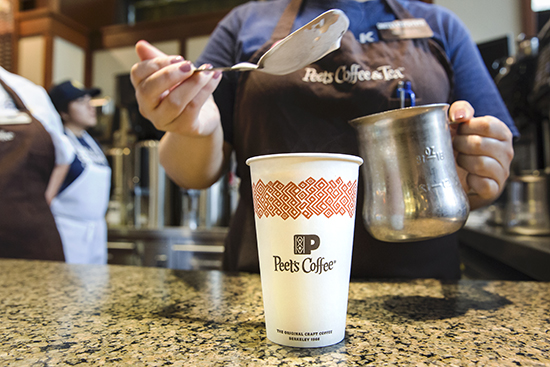
Peet’s decade-long relationship with UC Berkeley has now broadened to benefit the campus at large. (UC Berkeley photo by Brittany Hosea-Small)
At a time when state investment in Berkeley has dwindled to just 13 percent, UPP and Peet’s have signed a 10-year contract valued at $8 million in which Peet’s also will contribute campuswide support rare in university business partnerships: paid student internships, jobs for graduates, need-based scholarships, graduate student travel grants, aid for programs to stem student food insecurity, and funds for student-led gardening and environmental programs.
The expansive partnership is the fifth for UPP, which since 2015 also has brokered novel agreements with Under Armour, Brita, Bank of the West and Sungevity. It’s hard at work on several more — a communications partner will be chosen this spring for the campus, and an airline partner next fall.
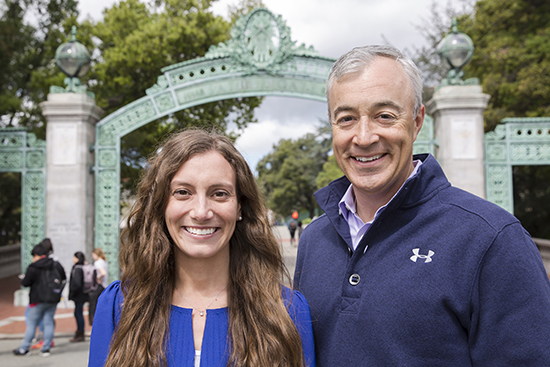
Solly Fulp (right) and Amy Gardner are leading UPP’s efforts to develop campuswide business partnerships that are sources of new revenue and student support. (UC Berkeley photo by Brittany Hosea-Small)
“Our priority was to find an innovative way to bring revenue and priority services to Berkeley, and the result was strategic, campuswide business partnerships,” explains Solly Fulp, executive director of the 2-year-old program. “Campus units had been pursuing business agreements individually, in silos. But by bringing multiple units together in a university-first approach, to benefit our students, we began building more meaningful partnerships with companies.”
Not only are these business relationships designed to benefit students, but UPP’s comprehensive governance model ensures they’re created and driven, in large part, by students, who sit at the bargaining table alongside faculty and staff.
“When we ask these companies to partner with us, it’s more than a contract,” says senior Wes Adrianson, the undergraduate representative on UPP’s Coffee and Tea Working Group, which chose Peet’s after a tough competition between nine companies, which represented a broad range of small to large companies. “We’re asking them to join our mission to change the world.”
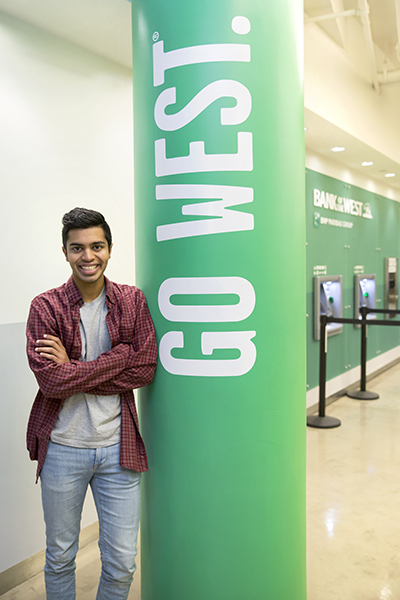
Undergraduate Raj Bhargava was the undergraduate representative on UPP’s banking working group, which chose Bank of the West. (UC Berkeley photo by Brittany Hosea-Small)
Among a handful of universities pioneering these broad relationships with businesses, Berkeley already is getting inquiries about UPP – particularly about the program’s governance model and process – from schools nationwide.
It’s also “a promising model” for other University of California campuses, says Nathan Brostrom, the UC system’s executive vice president and chief financial officer.
“We are actively looking into the possibility of utilizing that model,” he adds, “whether it’s two or three campuses participating together, or even something more broad-based across the UC system.”
At Louisiana State University, which has had several discussions with UC Berkeley about how its UPP is set up, “we’re exploring novel resource development models to see what’s working, and are excited to learn more,” says Dan Layzell, vice president for finance and administration. “What’s happening at Berkeley certainly seems relevant, given the current state of public higher education.”
Changing the culture
The idea for UPP arose in 2013 when Berkeley was seeking a naming rights partner for its football field, which is now Kabam Field at California Memorial Stadium. Fulp says members of the corporate community gave the campus feedback that they wanted “more than just logos and signage and public address announcements at a handful of athletic events a year.”
Instead, they were interested in “meaningful, sustainable relationships with the larger UC Berkeley community that create lifetime brand loyalty, career opportunities for students and authentic engagement,” not just opportunities with individual campus units, like athletics or the alumni association, says Fulp. And, because the campus is large and can be difficult to navigate, he adds, companies appreciate a single point of contact to connect with students, faculty, staff and alumni.
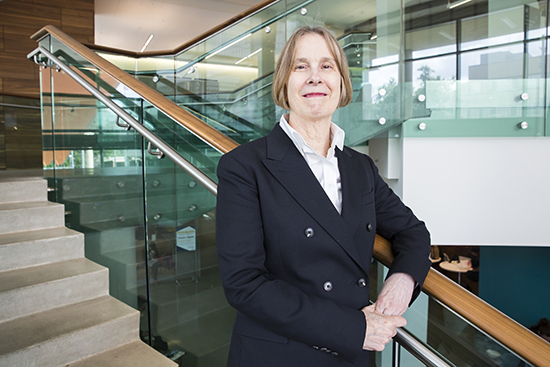
Business professor Nancy Wallace, on UPP’s advisory committee, says Berkeley had been “underleveraging its brand” before UPP came along. (UC Berkeley photo by Brittany Hosea-Small)
As for Berkeley, “like most state schools, it has been underleveraging its brand,” stresses Nancy Wallace, a professor at Berkeley’s Haas School of Business who’s on UPP’s advisory committee. “We have a world-class university with a broad-based student body and a public service mission that’s important. Corporations want to be part of that mission, and, of course, to have access to students who, after graduation, will continue to use their products and services. With UPP, there’s a benefit stream for both sides.”
UPP launched in 2015 and is changing the way the campus does business. “It isn’t always easy,” admits Fulp. “People and units on campus can be resistant to change and worry that, if they go into a business contract collectively, they’ll be giving up control and not getting as much value as they could on their own.”
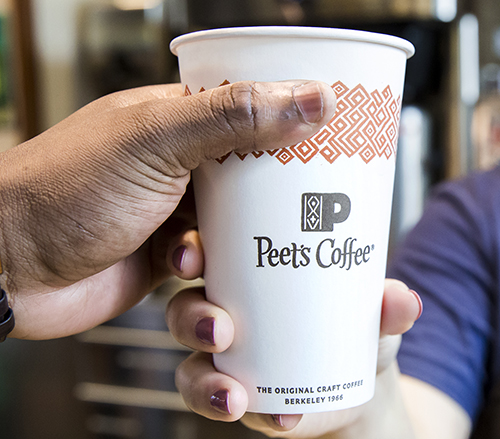
Peet’s will provide more than coffee to campus; it also will offer scholarships, internships and career opportunities to students. (UC Berkeley photo by Brittany Hosea-Small)
But that isn’t and won’t be the case, he says. “UPP guarantees that all departments with previous partnerships in a specific category, at a minimum, will receive the same benefits through UPP as they did on their own,” says Fulp, “and the intent is that they will fare better. By working together, the university has more leverage, and this benefits all units.”
UPP pursues only partnerships with potential to assist the entire campus and in categories with high campus purchasing expenses, expiring or limited campus agreements, growing industry engagement and a potential for shared values.
The Peet’s agreement, for example, has secured over three times as much annual revenue for the campus as all previous coffee sponsorships combined, along with other services that include capital investments and student internships.
Similarly, the partnership set up by UPP with Bank of the West procured nearly twice as much annual revenue as all previous campus banking contracts combined.
Another hurdle was students’ fear that the university is becoming “privatized.” But UPP’s goal isn’t to inundate Berkeley with business; it’s to involve stakeholders from across campus in creating a few key partnerships beneficial to the whole campus, says graduate student Aaron Smyth, a member of the UPP advisory committee.
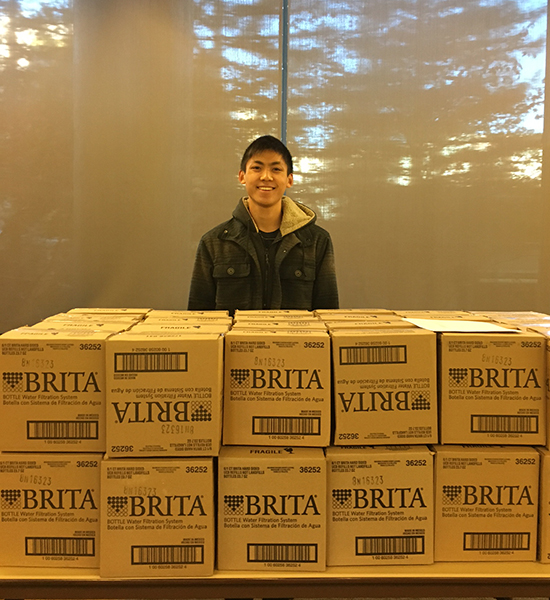
Campus partner Brita annually provides filtered water bottles to students in the residence halls. (University Partnership Program photo)
“As a result of UPP,” he adds, “not only are we seeing a larger investment from the companies we’re partnering with, but a broader distribution of those resources to groups that may not have had a voice at the table before.”
Andy Harmening didn’t expect to see a 10-member UPP working group awaiting him when he made a presentation to the campus in 2015 during its search for a banking partner. The then-vice chair of consumer banking for Bank of the West says he typically negotiates business contracts with just a few officials, and adds that seeing more than a dozen people at the table, including such young adults, was a first.
“I thought, ‘It looks like a lot of cooks in the kitchen,’” he recalls. “I found out quickly, though, that everyone had the same overarching goal of helping students, and Bank of the West wanted that as well. We wanted to meet that need through an inclusive conversation, a customer-first approach, a relationship.”
The bank won the bid, pledging UC Berkeley $17 million in revenue for 10 years that includes academic scholarships, internships, on-campus personal finance education for students and staff and funding for the growing UC Berkeley Food Pantry.
From transactional to transformational
“Bottom up” is the term UPP uses to describe why the program works well. A different working group of campus stakeholders – faculty, staff and students from across campus – develops and drives the details of each new partnership. They focus on criteria including product quality, variety and pricing, sourcing practices, commitment to sustainability, customer service, community initiatives and enhancement of Berkeley students’ educational experience.
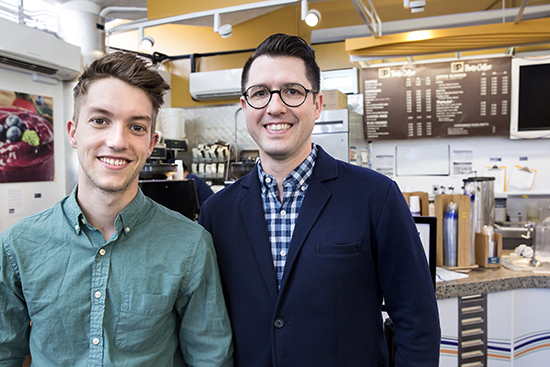
Undergrad Wes Adrianson (left) and grad student Aaron Smyth are UPP student representatives. (UC Berkeley photo by Brittany Hosea-Small)
Each working group then recommends partnership opportunities to the UPP advisory committee; the committee’s endorsements go to the campus’s finance committee for final approval.
Students are key ingredients in this strategy. Two students sit on each working group, the ASUC and Graduate Assembly presidents are on the UPP advisory committee, and an all-student UPP advisory committee – separate from the UPP’s advisory committee – includes students from each working group, plus several more from the campus at large.
“Our bottom-up approach is optimal,” says Amy Gardner, UPP’s director of project affairs, “because it allows each group, not campus leadership, to control how the partnership will affect them. By giving stakeholders power to shape the deal, they feel a sense of ownership. A top-down approach would make people hesitant and nervous about participation.”
Giving students and other stakeholders a large say in choosing campus business partners has led to hard bargains, but favorable results. For example, UPP insisted on a coffee and tea partner that would not require other coffee vendors on campus – Equator, Yali’s and Stradivarius, which runs the Free Speech Café – to leave. Among the finalists, Peet’s did not demand exclusivity.
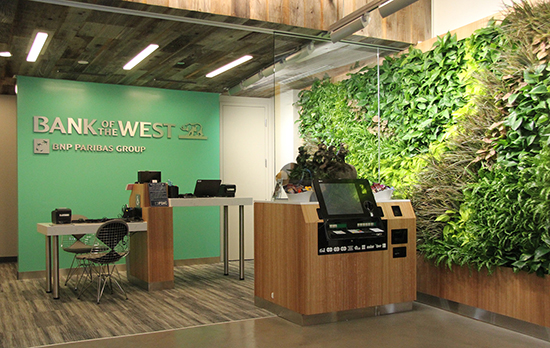
In the ASUC Student Union, Bank of the West’s branch has a living wall of plants and a smart ATM. (University Partnership Program photo)
Similarly, Bank of the West agreed, at the request of UPP student representatives, to not receive any guaranteed business based on new accounts opened. And Under Armour committed to a greater level of corporate social responsibility by becoming a member of the Sustainable Apparel Coalition.
And in its quest for more than transactional relationships with business partners, UPP insists upon, and is finding, companies that align with Berkeley’s values as a public university.
“UC Berkeley is in our DNA,” says Lauterbach, citing Peet’s long history with the campus, the Berkeley alumni in its workforce, the large number of lifelong “Peetniks” in the campus community, and the “creative, innovative and socially responsible values” that Berkeley and Peet’s share.

A new Peet’s coffee cart outside the Rec Sports Facility will serve Peet’s full menu. (UC Berkeley photo by Gretchen Kell)
“The UPP model,” he says, “allows the university to make sure it’s aligning with a partner that is doing more than just providing a product or service that meets a need.”
So far, the businesses chosen by UPP are allies already at work with Berkeley on ideas and projects to advance both campus and company, including:
- A sustainability and student health program with Brita, new water refill stations on campus, a joint filter-recycling effort between Brita and the campus’s Cal Zero Waste program, and collaboration on PartySafe@Cal’s Hydration Hype Squad, which encourages students to drink more water at parties.
- A collaboration between Bank of the West and Berkeley students on an annual on-campus Financial Literacy and Economic Justice Conference, to teach students about managing money and raise awareness of financial inequity among their peers.
- Plans with Under Armour to use its mobile fitness platforms to motivate students, faculty and staff toward better health and nutrition.
Berkeley’s UPP model “is in its infancy,” says Fulp, “but these companies have shown a genuine interest in transitioning from traditional sponsor agreements to partnerships with the whole campus community. We are creating truly innovative partnerships that benefit all.”